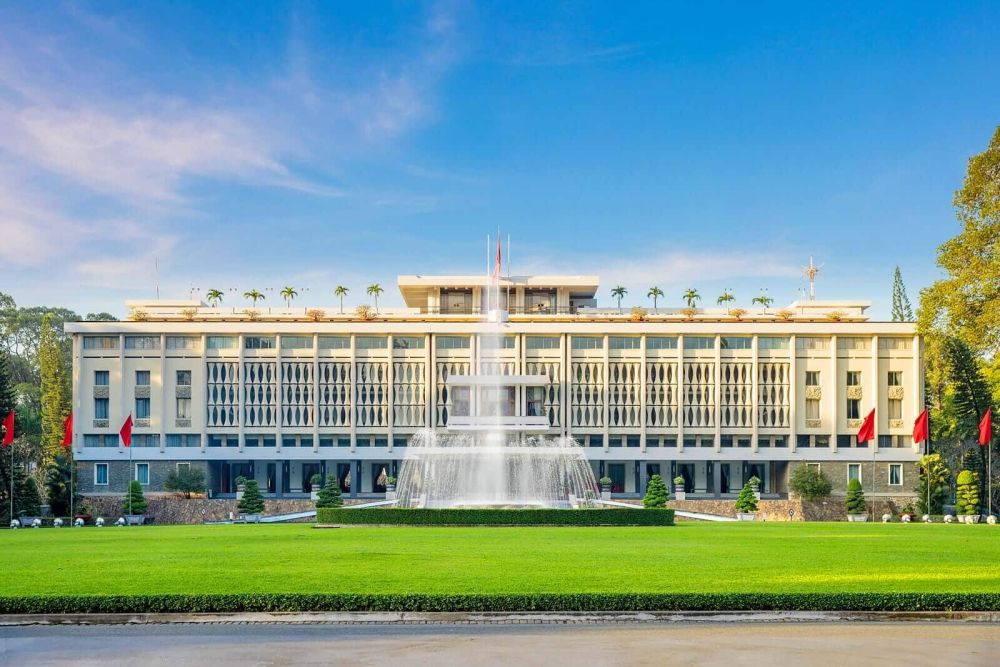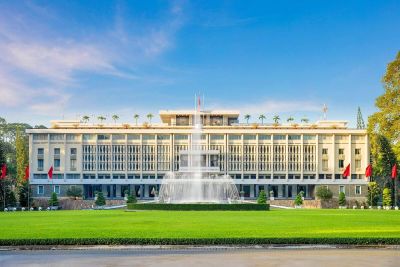

Discover the rich history of the Reunification Palace with a guided tour through this iconic building of Ho Chi Minh City. Built on the site of the former Norodom Palace, this building is a landmark of Vietnam's historical events, including the fall of Saigon in 1975 that marked the end of the Vietnam War. During the tour, participants will learn about the architecture, significant rooms such as the Presidential Office, the War Command Room, and the Reunification Hall. Visitors will hear stories of political intrigue, espionage, and the life of the South Vietnamese President. The tour is an eye-opening experience for history buffs and those interested in understanding Vietnam's past and the events that shaped the nation.
An audio tour of Reunification Palace is an excellent choice for individuals who prefer to explore at their own pace, while still receiving comprehensive information about the site. The audio guide provides detailed narratives about the palace's history, architecture, and the pivotal role it played during the Vietnam War. Visitors will be able to wander through the grand halls, state rooms, and even the bunker system, all while listening to captivating stories and historical facts. The audio tour is typically available in multiple languages and allows visitors to delve deep into the legacy of the building that witnessed the collapse of the South Vietnamese government.
For a unique experience, visitors can head to the basement of the Reunification Palace to explore the network of tunnels and bunkers. Designed to protect the president during wartime, this maze-like area includes telecommunications centers, war planning rooms, and maps still hanging on the walls, all preserved as they were during the 1970s. The tour not only highlights the ingenuity of the palace's defensive features but also tells the stories of the personnel who worked in these underground quarters. Those interested in military history and Cold War-era espionage will find this activity particularly engaging.
The lush gardens of the Reunification Palace make for a serene change of pace from the busy streets of Ho Chi Minh City. Join a garden walking tour to appreciate the well-maintained lawns, beautiful flora, and the landscaping artistry. The gardens are not only aesthetic but were also strategic for the palace's defense, with foliage designed to camouflage and protect the building. A knowledgeable guide will point out various indigenous and significant plant species while sharing the stories behind the design of the outdoor spaces. It's an opportunity to enjoy the tranquil surroundings and gain insight into the combination of function and beauty.
The Reunification Palace offers a unique backdrop for photographers, from its historical halls and state rooms to the lush gardens and classic 1960s architecture. Visitors can arrange for a photography session to capture the essence of this important national symbol. Professional and amateur photographers alike relish the chance to photograph the building's façade, the vintage furnishings, and the atmospheric bunker systems. While the interior offers a glimpse into the past with its retro styling, the exterior and gardens provide lush landscapes and interesting angles that make for great photo opportunities. Always remember to respect the rules regarding flash photography and restricted areas within the palace.
The Reunification Palace's ceremonial rooms are a window into the grandeur of state functions and official events. Visitors can explore the ornate banquet halls, the grand reception areas, and the presidential receiving rooms, where important dignitaries were once hosted. Exquisite decorations, luxurious furnishings, and meticulous restorations provide an authentic feel of the era. The tour through these ceremonial rooms will give insights into the cultural and political significance, protocols, and the artistry involved in statecraft. Guides often provide anecdotes about the events that took place within these walls, bringing to life the history of Vietnam's state affairs.
Throughout the year, Reunification Palace hosts various cultural exhibitions that showcase Vietnam's vibrant heritage and contemporary art. These exhibitions might feature historical photographs, traditional artifacts, or works by modern Vietnamese artists. Exploring these exhibits, visitors can gain deeper appreciation of the country's past and present, and the artistic talent that flourishes there. Each exhibition typically revolves around a specific theme relevant to Vietnamese culture or significant historical events. Local guides and exhibition curators are often available to provide context and answer questions, enriching the visitor's experience.
Occasionally, Reunification Palace organizes film screenings that are related to the history of Vietnam, particularly the Vietnam War period. These screenings include documentaries and feature films that reflect on the experiences during this turbulent time. This activity offers a visual and emotional complement to the information presented throughout the palace, deepening the understanding of Vietnam's struggles and resilience. Visitors are advised to check the schedule and language offerings for these screenings in advance, as they can be a not-to-miss experience for those interested in historical cinema and storytelling.
For those looking to engage more actively with Vietnam's culture, Reunification Palace sometimes holds interactive workshops. These may include traditional craft making, Vietnamese calligraphy, or cooking classes showcasing local cuisine. Participants will have the opportunity to learn from skilled artisans and chefs, creating their own souvenirs or dishes to take home. These workshops not only provide a hands-on cultural experience but also a chance to connect with local customs and practices in a meaningful way.
The Reunification Palace is not only a site of historical significance but also a place of learning and engagement for the younger generation. Educational programs are tailored to school groups, offering interactive tours, activities, and learning materials that align with the educational curriculum. These programs are designed to teach students about Vietnam's history, culture, and politics in an engaging manner. Such visits often highlight the importance of peace, understanding the consequences of conflict, and the value of heritage conservation.
